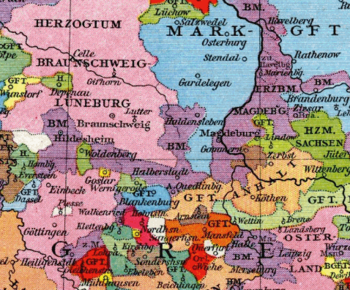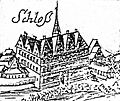Archbishopric of Magdeburg facts for kids
Quick facts for kids
Archbishopric of Magdeburg
|
|||||||||
|---|---|---|---|---|---|---|---|---|---|
| 1180–1680 | |||||||||

Prince-Bishoprics of Hildesheim, Halberstadt
and Magdeburg (violet), about 1250 |
|||||||||
| Status | Prince-Archbishopric | ||||||||
| Capital | |||||||||
| Common languages | Eastphalian | ||||||||
| Government | Hochstift | ||||||||
| Historical era | Middle Ages | ||||||||
| 968 | |||||||||
|
• Conquered Jüterbog
|
1157 1180 | ||||||||
| 1180 | |||||||||
|
• Subdued Halle
|
1478 | ||||||||
|
• Lower Saxon Circle
|
1500 | ||||||||
| 1513 | |||||||||
| 1680 | |||||||||
|
|||||||||
The Archbishopric of Magdeburg was an important area in the Holy Roman Empire. It was a large church region (an archdiocese) from 969 to 1552. It also became a powerful state ruled by an archbishop, known as a Prince-Archbishopric, from 1180 to 1680. It was centered around the city of Magdeburg near the Elbe River.
Over time, the leaders of the Archbishopric changed. After 1557, the archbishops were mostly administrators who followed the Protestant faith, even though the area was originally Catholic. The only Catholic leader during this time was Leopold William of Austria (1631–1635). For the remaining Catholics, their churches were looked after by other Catholic leaders.
As a state, the Prince-Archbishopric of Magdeburg had its own land and power. It included the city of Magdeburg and other important areas like the Magdeburg Börde and Jerichow Land. It was like a small kingdom where the archbishop was the ruler. This state lasted until 1680. After that, it became the Duchy of Magdeburg, which was then ruled by the Brandenburg-Prussia family.
Today, there is a modern Diocese of Magdeburg that was founded in 1994. It is a Catholic church region in parts of Germany, including Saxony-Anhalt, Brandenburg, and Saxony.
Contents
History of Magdeburg
The city of Magdeburg was a very old trading center for the Germans and the Wends, who lived on the other side of the Elbe River. It was first mentioned in history in 805. In 806, Charlemagne built a fortress there. The oldest church in the area is also from this time.
Magdeburg became very important during the rule of Otto the Great (936-973). In 929, King Otto I gave the city to his wife, Edith. She loved the city and often lived there. In 937, Otto and Edith started a monastery in Magdeburg.
After some wars, the Polabian Slavs were brought under German rule. However, the Magyars (a group from Eastern Europe) attacked Germany. They were defeated at the Battle of Lechfeld in 955. After this victory, Otto wanted to create an archbishopric in Magdeburg. He hoped this would help spread Christianity in the eastern lands. He wanted to move the main church center from Halberstadt to Magdeburg. But the Archbishop of Mainz strongly disagreed with this plan.
In 962, Pope John XII agreed to the idea of an archbishopric. The land belonging to the monastery founded in 937 was given to the new archbishopric. The monastery church became the Cathedral of St. Maurice.
The new church region included other important areas like Brandenburg, Havelberg, Merseburg, Zeitz, and Meißen. Later, Lebus was added in 1424. This new archbishopric was near the borders of the Holy Roman Empire and Slavic tribes. Its main goal was to spread Christianity among these people. On April 20, 967, the archbishopric was officially created. The first archbishop was Adelbert. He was chosen in 968 and became the leader of the church in Magdeburg.
The area of the archdiocese was not very large. It included some Slavic districts and parts of Thuringia. The cathedral school in Magdeburg became very famous under Adelbert's leadership. Many smart people were educated there.
After Adelbert died in 981, Othrich became archbishop. Later, Gisiler of Merseburg took over. When he died in 1004, Tagino became archbishop. He and his helpers were important for military service in the eastern border regions.
Other important archbishops included Gero (1012–1023) and St. Norbert (1126–1134). St. Norbert was the founder of the Premonstratensian religious order.
Archbishop Wichmann (1152–1192) was a powerful ruler and prince of the Holy Roman Empire. He was more important as a political leader than just a bishop. Wichmann supported the emperor during a big revolt. As a reward, the archbishopric's lands were recognized as an independent state within the Holy Roman Empire. This made Wichmann the first to be both an archbishop and a secular prince.
Later, Albrecht II (1205–1232) had conflicts with Otto II, Margrave of Brandenburg. This war caused a lot of damage to the archbishopric. In 1208, he started building the current Cathedral of Magdeburg. It was finished in 1263, but never fully completed.
Cardinal Albert of Brandenburg (1513–1545) faced many challenges, including money problems. This allowed Lutheranism to spread in his area, even though he was against the Reformation. It's not true that he became a Lutheran. His successors, John Albert of Brandenburg-Ansbach (1545–1550) and Frederick IV of Brandenburg (who died in 1552), were strong Catholics but could not do much to stop the changes.
After 1552, the archdiocese was mostly led by administrators who were Protestant princes. They belonged to the House of Brandenburg family. Christian William was captured in 1631 and became Catholic. Later, in 1635, the Archbishopric of Magdeburg came under the rule of August, Duke of Saxe-Weissenfels.
In the Treaty of Westphalia (1648), it was agreed that when August died, the archbishopric would go to Brandenburg-Prussia. When August died in 1680, the archbishopric was changed from a church state into the Duchy of Magdeburg. It became a regular duchy ruled by the Brandenburg family.
The remaining Catholics in the area were looked after by different church leaders over the years. In 1994, the modern Diocese of Magdeburg was created for Catholics in the region.
Archbishops and administrators
Here is a list of the main leaders of the Archbishopric of Magdeburg over the centuries. They were first archbishops, then prince-archbishops who also ruled the territory, and finally administrators.
Archbishops of Magdeburg
- Adalbert 968–981
- Giselmar 981–1004
- Tagino 1004–1012
- Waltaro 1012
- Gero 1012–1023
- Humfrid 1023–1051
- Engelhard 1052–1063
- Werner of Steutzlingen 1064–1078
- Hartwig of Spanheim 1079–1102
- Henry I of Assel 1102–1107
- Adalgod of Osterberg 1107–1119
- Rudigar of Baltheim 1119–1125
- Norbert of Xanten 1126–1134
- Conrad I of Querfurt 1134–1142
- Frederick of Wettin 1142–1152
- Wichmann von Seeburg 1152–1180; prince-archbishop to 1192; Bishop of Naumburg, 1150–54
1180: Gained Imperial immediacy on breakup of duchy of Saxony
Prince-archbishops of Magdeburg
- Wichmann von Seeburg 1180–1192; archbishop from 1152
- Ludolf of Koppenstedt 1192–1205
- Albert I of Käfernburg 1205–1232
- Burkhard I of Woldenberg 1232–1235
- Wilbrand of Kasernberg 1235–1254
- Rudolf of Dinselstadt 1254–1260
- Rupert of Mansfeld 1260–1266
- Conrad II of Sternberg 1266–1277
- Günther I of Schwalenberg 1277–1279
- Bernhard III of Wolpe 1279–1282
- Eric of Brandenburg 1282–1295
- Burkhard II of Blankenburg 1295–1305
- Henry III, Prince of Anhalt-Aschersleben 1305–1307
- Burkhard III of Mansfeld-Schrapglau 1307–1325
- Heideke of Erssa 1326–1327
- Otto of Hesse 1327–1361
- Dietrich Kagelwit 1361–1367
- Albert II of Sternberg 1367–1372
- Peter Gelvto 1372–1381
- Louis of Meissen 1381–1382
- Frederick II of Hoym 1382
- Albert III of Querfurt 1382–1403
- Günther II of Schwarzburg 1403–1445
- Frederick III of Beichlingen 1445–1464
- John II of Palatinate-Simmern 1464–1475
- Ernest II of Saxony 1475–1480; prince-archbishop to 1513
1480: Prince-Bishopric of Halberstadt administered by archbishops of Magdeburg
Prince-archbishops of Magdeburg, administrators of Halberstadt
- Ernest II of Saxony 1480–1513; prince-archbishop from 1475
- Albert IV of Brandenburg 1513–1545; also archbishop-elector of Mainz from 1514–1545
- John Albert of Brandenburg-Ansbach 1545–1551
- Frederick IV of Brandenburg 1551–1552; Frederick III as administrator of Halberstadt
- Sigismund of Brandenburg 1552–1566; papally confirmed as archbishop although Lutheran, since the Holy See still expected the new schism to be a temporary phenomenon
1566: Archdiocese ruled by Lutheran administrators
Administrators of Magdeburg
- Joachim Frederick of Brandenburg 1566–1598
- Christian William of Brandenburg 1598–1631
- Leopold William of Austria, a layman, Catholic administrator, 1631–1638; also administrator of the prince-bishoprics of Passau (1625–1662), of Strasbourg (1626–1662), of Halberstadt (1628–1648), of Olmütz (1632–1662) and of Breslau (1656–1662) and de jure of the prince-archbishopric of Bremen (1635–1645)
- Augustus, Duke of Saxe-Weissenfels, Count of Barby, 1638–1680
1680: Prince-Archbishopric secularised to duchy
Ecclesiastical Province of Magdeburg
The archbishop of Magdeburg was the main church leader (the metropolitan) of the Ecclesiastical Province of Magdeburg. This church province was effectively dissolved in 1648. The archbishops also held an important honorary title, Primas Germaniae. The bishops under Magdeburg's authority were:
- Diocese of Brandenburg, which became Lutheran in 1539. Its related state was merged into the Electorate of Brandenburg in 1571.
- Diocese of Havelberg, which became Lutheran in 1558. Its related state was merged into the Electorate of Brandenburg in 1598.
- Diocese of Lebus since 1424 (before that, it was under Gniezno). It became Lutheran in 1555. Its related lands were merged into the Electorate of Brandenburg in 1598.
- Diocese of Merseburg, which became Lutheran in 1544. Its related state was merged into the Electorate of Saxony in 1565.
- Diocese of Naumburg-Zeitz, which was Lutheran at different times and from 1562 onwards. Its related state was merged into the Electorate of Saxony in 1615.
Residences
The Archbishops of Magdeburg lived in several places. Here are some of their main homes:
-
Giebichenstein Castle in Halle (Saale)
-
Moritzburg in Halle
See also
- Bull of Gniezno










